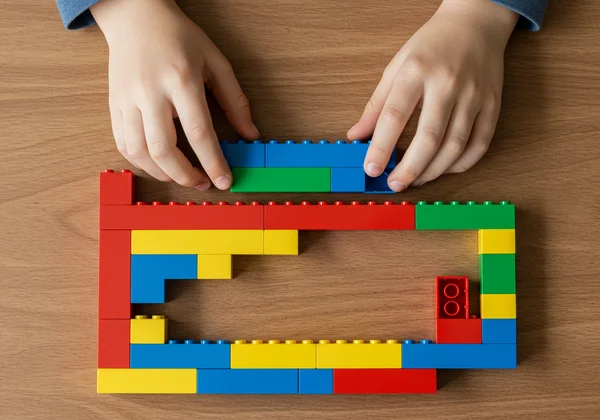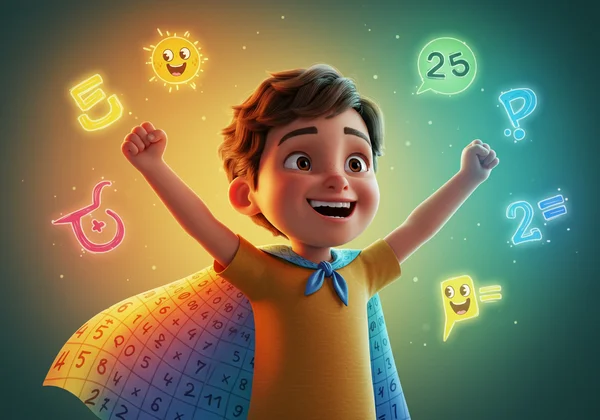Using the Multiplication Table in Real Life: 10 Surprising Examples
As a parent or teacher, you’ve likely heard it: the classic sigh followed by, "When will I ever use this in real life?" It’s a fair question, especially when it comes to learning the multiplication table. For many kids, multiplication feels like just another list of facts to memorize for a test. But what if we told you it’s actually a hidden superpower they use every single day? The truth is, real life multiplication is everywhere, from the video games they love to the snacks they share with friends. Why is it important to learn the multiplication table? Because it unlocks a faster, smarter way of understanding the world.

This article will reveal 10 surprising and practical ways we use multiplication in everyday life. These examples will help you show your child that math isn't just about numbers on a page—it's about a powerful tool for solving real problems. By the end, you'll be ready to help them master this essential skill with confidence and maybe even a little bit of fun.
Why Learn Multiplication? It's Everywhere!
Before we get to the fun stuff, let's look at how multiplication quietly runs in the background of our daily routines. These examples are perfect for showing kids that they're probably already using multiplication without even realizing it. Mastering the times tables makes these everyday tasks much faster and easier.
1. At the Grocery Store: Calculating Costs Quickly
Imagine you're at the grocery store and your child wants to buy four yogurt cups. Each one costs $2. Instead of adding $2 + $2 + $2 + $2, you can instantly use multiplication: 4 yogurts × $2 each = $8. This quick mental math helps in budgeting and making smart purchasing decisions on the fly.
This skill becomes even more crucial when comparing prices. Is a pack of 6 juice boxes for $9 a better deal than a pack of 8 for $11? Multiplication helps you calculate the price per item to find the answer. It’s the first step towards financial literacy, and it starts right here in the shopping aisle.
2. In the Kitchen: Scaling a Recipe Up or Down
Have you ever needed to double a cookie recipe for a bake sale or halve a dinner recipe for a smaller family meal? That’s multiplication in action! If a recipe calls for 2 cups of flour and you need to make a double batch, you multiply 2 × 2 to know you need 4 cups.
This is a fantastic, hands-on way to demonstrate practical math. Let your child be the "Head Chef of Calculations." If a cupcake recipe that makes 12 cupcakes requires 3 eggs, and you want to make 24, ask them how many eggs you'll need. They'll use their 2s times table to figure it out (2 x 3 = 6 eggs), seeing a delicious and tangible result of their math skills.

3. Planning a Party: Sharing Goodies Equally
Party planning is filled with multiplication. Let's say you're preparing goodie bags for 8 friends. If you want to put 5 pieces of candy in each bag, how many candies do you need to buy? Instead of counting one by one, you can simply multiply: 8 bags × 5 candies = 40 candies.
This applies to everything from sending invitations to arranging chairs. If you need to set up 4 tables with 6 chairs at each, multiplication (4 × 6 = 24) tells you instantly if you have enough seating for all your guests. It’s an organizational superpower that ensures everyone gets their fair share of the fun. To make learning these facts easier, an interactive times table chart can be a great visual aid.
4. Managing Pocket Money: Tracking Savings
Understanding multiplication is fundamental to managing money. If your child receives $5 in allowance each week, they can calculate how much they’ll save over time. After 4 weeks, they’ll have 4 × $5 = $20. Want to save up for a $50 toy? They can use multiplication to figure out it will take them 10 weeks.
This simple calculation empowers children to set financial goals and understand the value of consistent saving. It transforms the abstract concept of "saving money" into a concrete, achievable plan. This is a life skill that will serve them well long after they've left the classroom.
5. Telling Time: Calculating Future Minutes
While we live in an age of digital clocks, understanding time often involves multiplication. If a TV show starts in 2 hours, how many minutes is that? Knowing that there are 60 minutes in an hour, you multiply 2 × 60 to get 120 minutes.
This also works for smaller intervals. If your bus arrives every 10 minutes and you just missed it, you know the next three buses will arrive in 10, 20, and 30 minutes. This is just reciting the 10s times table! Understanding these calculations helps kids develop a better sense of time management and planning.
Practical Math for Kids: From Hobbies to Games
Now for the really fun part. Multiplication isn’t just for chores and errands; it’s at the heart of many activities kids already love. Connecting math to their hobbies is one of the most effective ways to boost their motivation and show them that numbers can be exciting.
6. In Video Games: Understanding Scores and Power-ups
Video games are secretly packed with math. When a player collects a coin and gets a "2x score multiplier," they are using multiplication to figure out their new points. If they defeat a monster worth 50 points with that multiplier active, they get 50 × 2 = 100 points!
Crafting systems in games like Minecraft also rely on multiplication. If one sword requires 2 iron ingots, how many ingots do you need to make 5 swords for you and your friends? That’s 5 × 2 = 10 ingots. Pointing this out can be a huge "aha!" moment for a child who thinks they don't like math but loves gaming. Practicing with fun multiplication games can make these connections even clearer.
7. Building with LEGOs: Creating Symmetrical Designs
Building with LEGOs or other construction blocks is a lesson in spatial reasoning and, you guessed it, multiplication. If you're building a rectangular wall that is 10 studs long and 8 bricks high, you can calculate the total number of bricks needed on the surface by multiplying 10 × 8 = 80.
This visual representation is incredibly powerful. It helps children see multiplication as "groups of" numbers, which is the core concept. A multiplication grid is essentially a chart of LEGO bricks. This connection makes abstract numbers feel solid and real.

8. Planning a Trip: Estimating Travel Time
Are we there yet? This age-old question can be answered with multiplication. If you're on a road trip and plan to travel at an average speed of 60 miles per hour, you can estimate your progress. In 3 hours, you will have traveled approximately 3 × 60 = 180 miles.
This helps kids understand distance and time on a larger scale. It also works for shorter distances. If you're walking and it takes 2 minutes to get to the end of the block, you can estimate that it will take 10 minutes to walk 5 blocks (5 x 2 = 10). It's a great way to make long journeys feel more manageable.
9. Following Sports: Reading Player Statistics
For any young sports fan, multiplication is key to understanding the game. If their favorite basketball player scores five 3-point shots in a game, they can quickly calculate that the player earned 5 × 3 = 15 points just from those shots. In American football, 4 touchdowns are worth 4 × 6 = 24 points (before extra points).
Following player stats, team standings, and season records all involve basic multiplication. This is a great way to engage a child who is passionate about sports but less enthusiastic about math homework. They're already using the skills; now they just need to recognize it. You can use our free math resources to help them practice.
10. Doing Crafts: Measuring and Cutting Materials
Craft time is a perfect opportunity for some stealthy math practice. Imagine you're making friendship bracelets and each one requires 3 different colored strings, each 12 inches long. If you want to make 4 bracelets, you'll need 4 × 3 = 12 strings in total.
Similarly, if a sewing project requires cutting 5 fabric squares that are each 4 inches by 4 inches, multiplication helps you plan how much fabric you need. It ensures you have enough material and reduces waste. This shows that accuracy in math leads to better results in creative projects.
Turn Multiplication into an Everyday Superpower
See? Multiplication isn't just a list of facts for a test—it's a secret superpower for navigating the world. It helps us budget at the store, create in the kitchen, and even win at video games. When you connect multiplication to the things your child already loves, you transform it from a boring chore into a skill they'll be genuinely excited to master.

Now that you see just how useful multiplication is, are you ready to help your child master it? The key is to make learning engaging and intuitive. Make learning fun and easy with our FREE interactive multiplication chart! Our visual tools, color-coding features, and printable resources are designed to turn memorization into a game of discovery.
Answering Your Questions About Learning Multiplication
Why is it important to learn the multiplication table?
Learning the multiplication table is crucial because it builds a strong foundation for almost all other areas of math, including division, fractions, and algebra. Beyond school, it boosts mental math skills, allowing for quick calculations in everyday situations like shopping and cooking. This builds confidence and problem-solving abilities that are valuable throughout life.
What are the easiest ways to learn multiplication?
There is no single "easiest" way, as it depends on the child's learning style. However, effective methods include breaking the table into smaller, manageable chunks (like learning the 2s, 5s, and 10s first), identifying patterns (like the 9s trick), and using visual aids. The most powerful method is making it interactive. Using tools like our interactive tool, where kids can click, see patterns with colors, and get instant feedback, transforms learning from a passive task to an active exploration.
How can I help my child learn multiplication when they find it boring?
The best way to combat boredom is to make learning relevant and fun. First, connect multiplication to their interests, using the real-world examples from this article, like video games or sports. Second, turn practice into a game. Challenge them to a speed round, use flashcards, or let them explore our multiplication chart like a digital playground. When a child feels like they are playing instead of studying, their motivation and retention skyrocket.